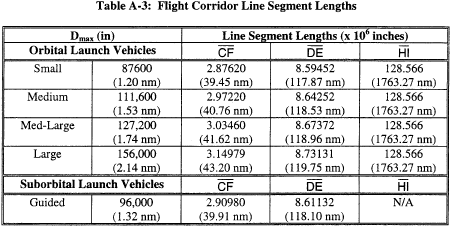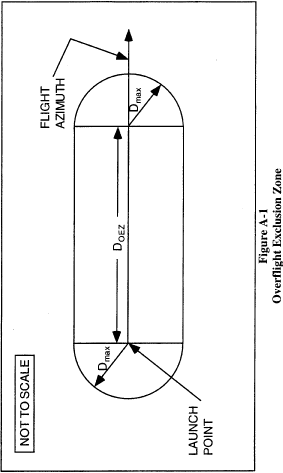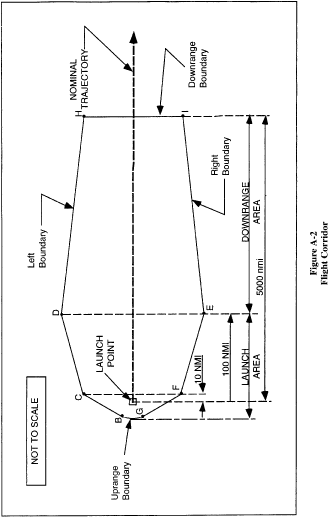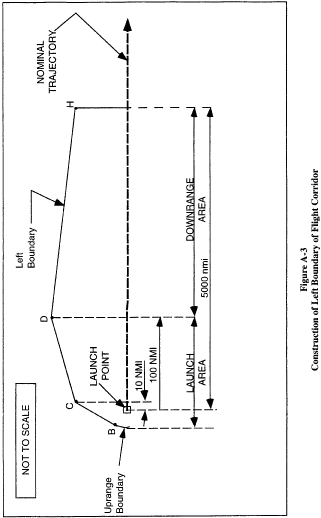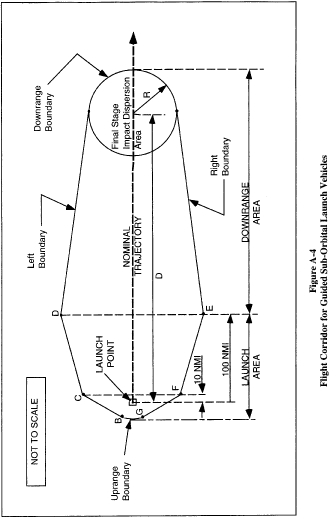Appendix A to Part 420 - Method for Defining a Flight Corridor
14:4.0.2.9.12.6.24.1.26 : Appendix A
Appendix A to Part 420 - Method for Defining a Flight Corridor (a)
Introduction
(1) This appendix provides a method for constructing a flight
corridor from a launch point for a guided suborbital launch vehicle
or any one of the four classes of guided orbital launch vehicles
from table 1, § 420.19, without the use of local meteorological
data or a launch vehicle trajectory.
(2) A flight corridor includes an overflight exclusion zone in a
launch area and, for a guided suborbital launch vehicle, an impact
dispersion area in a downrange area. A flight corridor for a guided
suborbital launch vehicle ends with the impact dispersion area,
and, for the four classes of guided orbital launch vehicles, 5000
nautical miles (nm) from the launch point.
(b) Data requirements
(1) Maps. An applicant shall use any map for the launch site
region with a scale not less than 1:250,000 inches per inch in the
launch area and 1:20,000,000 inches per inch in the downrange area.
As described in paragraph (b)(2), an applicant shall use a
mechanical method, a semi-automated method, or a fully-automated
method to plot a flight corridor on maps. A source for paper maps
acceptable to the FAA is the U.S. Dept. of Commerce, National
Oceanic and Atmospheric Administration, National Ocean Service.
(i) Projections for mechanical plotting method. An applicant
shall use a conic projection. The FAA will accept a
“Lambert-Conformal” conic projection. A polar aspect of a
plane-azimuthal projection may also be used for far northern launch
sites.
(ii) Projections for semi-automated plotting method. An
applicant shall use cylindrical, conic, or plane projections for
semi-automated plotting. The FAA will accept “Mercator” and
“Oblique Mercator” cylindrical projections. The FAA will accept
“Lambert-Conformal” and “Albers Equal-Area” conic projections. The
FAA will accept “Lambert Azimuthal Equal-Area” and “Azimuthal
Equidistant” plane projections.
(iii) Projections for fully-automated plotting method. The FAA
will accept map projections used by geographical information system
software scaleable pursuant to the requirements of paragraph
(b)(1).
(2) Plotting Methods.
(i) Mechanical method. An applicant may use mechanical drafting
equipment such as pencil, straight edge, ruler, protractor, and
compass to plot the location of a flight corridor on a map. The FAA
will accept straight lines for distances less than or equal to 7.5
times the map scale on map scales greater than or equal to
1:1,000,000 inches per inch (in/in); or straight lines representing
100 nm or less on map scales less than 1:1,000,000 in/in.
(ii) Semi-automated method. An applicant may employ the range
and bearing techniques in paragraph (b)(3) to create latitude and
longitude points on a map. The FAA will accept straight lines for
distances less than or equal to 7.5 times the map scale on map
scales greater than or equal to 1:1,000,000 inches per inch
(in/in); or straight lines representing 100 nm or less on map
scales less than 1:1,000,000 in/in.
(iii) Fully-automated method. An applicant may use geographical
information system software with global mapping data scaleable in
accordance with paragraph (b)(1).
(3) Range and bearing computations on an ellipsoidal Earth
model.
(i) To create latitude and longitude pairs on an ellipsoidal
Earth model, an applicant shall use the following equations to
calculate geodetic latitude (+N) and longitude (+E) given the
launch point geodetic latitude (+N), longitude (+E), range (nm),
and bearing (degrees, positive clockwise from North).
(A) Input. An applicant shall use the following input in making
range and bearing computations. Angle units must be in radians.
(B) Computations. An applicant shall use the following equations
to determine the latitude (φ2) and longitude (λ2) of a target point
situated “S” nm from the launch point on an azimuth bearing (α12)
degrees.
where: a = WGS-84 semi-major axis
(3443.91846652 nmi) b = WGS-84 semi-minor axis (3432.37165994 nmi)
(ii) To create latitude and longitude pairs on an ellipsoidal
Earth model, an applicant shall use the following equations to
calculate the distance (S) of the geodesic between two points (P1
and P2), the forward azimuth (α12) of the geodesic at P1, and the
back azimuth (α21) of the geodesic at P2, given the geodetic
latitude (+N), longitude (+E) of P1 and P2. Azimuth is measured
positively clockwise from North.
(A) Input. An applicant shall use the following input. Units
must be in radians.
(B) Computations. An applicant shall use the following equations
to determine the distance (S), the forward azimuth (α12) of the
geodesic at P1, and the back azimuth (α12) of the geodesic at
P2.
where: a = WGS-84 semi-major axis
(3443.91846652 nmi) b = WGS-84 semi-minor axis (3432.37165994 nmi)
(c) Creation of a Flight Corridor
(1) To define a flight corridor, an applicant shall:
(i) Select a guided suborbital or orbital launch vehicle, and,
for an orbital launch vehicle, select from table 1 of § 420.19 a
launch vehicle weight class that best represents the launch vehicle
the applicant plans to support at its launch point;
(ii) Select a debris dispersion radius (Dmax) from table A-1
corresponding to the guided suborbital launch vehicle or orbital
launch vehicle class selected in paragraph (c)(1)(i);
(iii) Select a launch point geodetic latitude and longitude;
and
(iv) Select a flight azimuth.
(2) An applicant shall define and map an overflight exclusion
zone using the following method:
(i) Select a debris dispersion radius (Dmax) from table A-1 and
a downrange distance (DOEZ) from table A-2 to define an overflight
exclusion zone for the guided suborbital launch vehicle or orbital
launch vehicle class selected in paragraph (c)(1)(i).
(ii) An overflight exclusion zone is described by the
intersection of the following boundaries, which are depicted in
figure A-1:
(A) An applicant shall define an uprange boundary with a
half-circle arc of radius Dmax and a chord of length twice Dmax
connecting the half-circle arc endpoints. The uprange boundary
placement on a map has the chord midpoint positioned on the launch
point with the chord oriented along an azimuth ±90°from the launch
azimuth and the half-circle arc located uprange from the launch
point.
(B) An applicant shall define the downrange boundary with a
half-circle arc of radius Dmax and a chord of length twice Dmax
connecting the half-circle arc endpoints. The downrange boundary
placement on a map has the chord midpoint intersecting the nominal
flight azimuth line at a distance DOEZ inches downrange with the
chord oriented along an azimuth ±90°from the launch azimuth and the
half-circle arc located downrange from the intersection of the
chord and the flight azimuth line.
(C) Crossrange boundaries of an overflight exclusion zone are
defined by two lines segments. Each is parallel to the flight
azimuth with one to the left side and one to the right side of the
flight azimuth line. Each line connects an uprange half-circle arc
endpoint to a downrange half-circle arc endpoint as shown in figure
A-1.
(iii) An applicant shall identify the overflight exclusion zone
on a map that meets the requirements of paragraph (b).
(3) An applicant shall define and map a flight corridor using
the following method:
(i) In accordance with paragraph (b), an applicant shall draw a
flight corridor on one or more maps with the Dmax origin centered
on the intended launch point and the flight corridor centerline (in
the downrange direction) aligned with the initial flight azimuth.
The flight corridor is depicted in figure A-2 and its line segment
lengths are tabulated in table A-3.
(ii) An applicant shall define the flight corridor using the
following boundary definitions:
(A) An applicant shall draw an uprange boundary, which is
defined by an arc-line GB (figure A-2), directly uprange from and
centered on the intended launch point with radius Dmax.
(B) An applicant shall draw line CF perpendicular to and
centered on the flight azimuth line, and positioned 10 nm downrange
from the launch point. The applicant shall use the length of line
CF provided in table A-3 corresponding to the guided suborbital
launch vehicle or orbital launch vehicle class selected in
paragraph (c)(1)(i).
(C) An applicant shall draw line DE perpendicular to and
centered on the flight azimuth line, and positioned 100 nm
downrange from the launch point. The applicant shall use the length
of line DE provided in table A-3 corresponding to the guided
suborbital launch vehicle or orbital launch vehicle class selected
in paragraph (c)(1)(i).
(D) Except for a guided suborbital launch vehicle, an applicant
shall draw a downrange boundary, which is defined by line HI and is
drawn perpendicular to and centered on the flight azimuth line, and
positioned 5,000 nm downrange from the launch point. The applicant
shall use the length of line HI provided in table A-3 corresponding
to the orbital launch vehicle class selected in paragraph
(c)(1)(i).
(E) An applicant shall draw crossrange boundaries, which are
defined by three lines on the left side and three lines on the
right side of the flight azimuth. An applicant shall construct the
left flight corridor boundary according to the following, and as
depicted in figure A-3 :
(1) The first line (line BC in figure A-3) is tangent to the
uprange boundary arc, and ends at endpoint C of line CF, as
depicted in figure A-3;
(2) The second line (line CD in figure A-3) begins at endpoint C
of line BC and ends at endpoint D of line DH, as depicted in figure
A-3;
(3) For all orbital launch vehicles, the third line (line DH in
figure A-3) begins at endpoint D of line CD and ends at endpoint H
of line HI, as depicted in figure A-3; and
(4) For a guided suborbital launch vehicle, the line DH begins
at endpoint D of line CD and ends at a point tangent to the impact
dispersion area drawn in accordance with paragraph (c)(4) and as
depicted in figure A-4.
(F) An applicant shall repeat the procedure in paragraph
(c)(3)(ii)(E) for the right side boundary.
(iii) An applicant shall identify the flight corridor on a map
that meets the requirements of paragraph (b).
(4) For a guided suborbital launch vehicle, an applicant shall
define a final stage impact dispersion area as part of the flight
corridor and show the impact dispersion area on a map, as depicted
in figure A-4, in accordance with the following:
(i) An applicant shall select an apogee altitude (Hap) for the
launch vehicle final stage. The apogee altitude should equal the
highest altitude intended to be reached by a guided suborbital
launch vehicle launched from the launch point.
(ii) An applicant shall define the impact dispersion area by
using an impact range factor [IP(Hap)] and a dispersion factor
[DISP(Hap)] as shown below:
(A) An applicant shall calculate the impact range (D) for the
final launch vehicle stage. An applicant shall set D equal to the
maximum apogee altitude (Hap) multiplied by the impact range factor
as shown below:
where: IP(Hap) = 0.4 for an apogee less than
100 km; and IP(Hap) = 0.7 for an apogee 100 km or greater.
(B) An applicant shall calculate the impact dispersion radius
(R) for the final launch vehicle stage. An applicant shall set R
equal to the maximum apogee altitude (Hap) multiplied by the
dispersion factor as shown below:
where: DISP(Hap) = 0.05
(iii) An applicant shall draw the impact dispersion area on a
map with its center on the predicted impact point. An applicant
shall then draw line DH in accordance with paragraph
(c)(3)(ii)(E)(4).
(d) Evaluate the Flight Corridor
(1) An applicant shall evaluate the flight corridor for the
presence of any populated areas. If an applicant determines that no
populated area is located within the flight corridor, then no
additional steps are necessary.
(2) If a populated area is located in an overflight exclusion
zone, an applicant may modify its proposal or demonstrate that
there are times when no people are present or that the applicant
has an agreement in place to evacuate the public from the
overflight exclusion zone during a launch.
(3) If a populated area is located within the flight corridor,
an applicant may modify its proposal and create another flight
corridor pursuant to appendix A, use appendix B to narrow the
flight corridor, or complete a risk analysis in accordance with
appendix C.
Table A-1 - Debris Dispersion Radius (Dmax)
(in)
| Orbital launch
vehicles |
Suborbital launch
vehicles |
| Small |
Medium |
Medium large |
Large |
Guided |
87,600
(1.20 nm) |
111,600
(1.53 nm) |
127,200
(1.74 nm) |
156,000
(2.14 nm) |
96,000
(1.32 nm) |
Table A-2 - Overflight Exclusion Zone
Downrange Distance (Doez) (in)
| Orbital launch
vehicles |
Suborbital launch
vehicles |
| Small |
Medium |
Medium large |
Large |
Guided |
240,500
(3.30 nm) |
253,000
(3.47 nm) |
310,300
(4.26 nm) |
937,700
(12.86 nm) |
232,100
(3.18 nm) |
